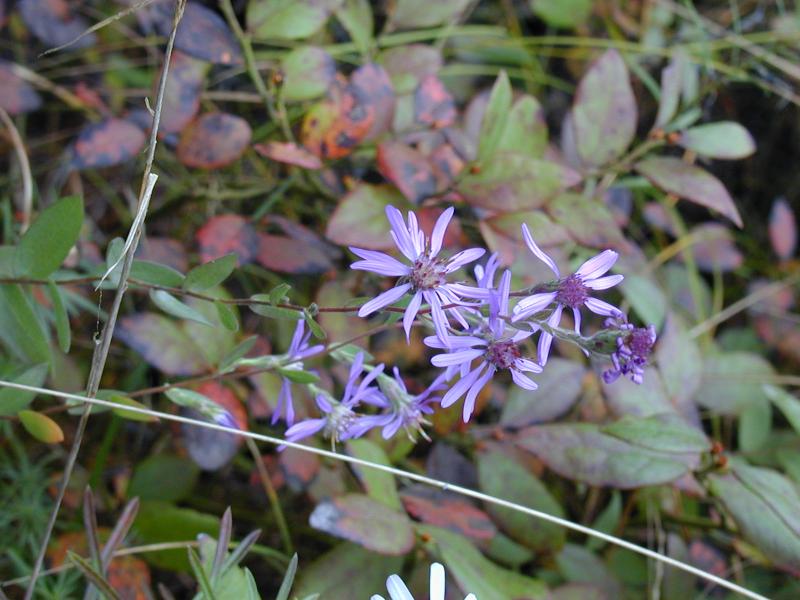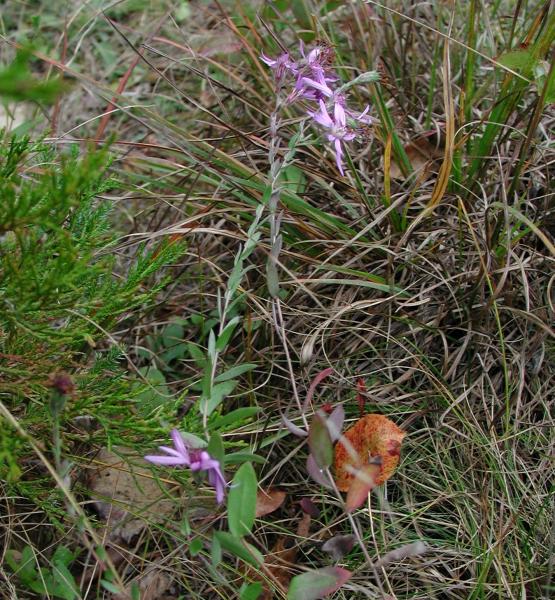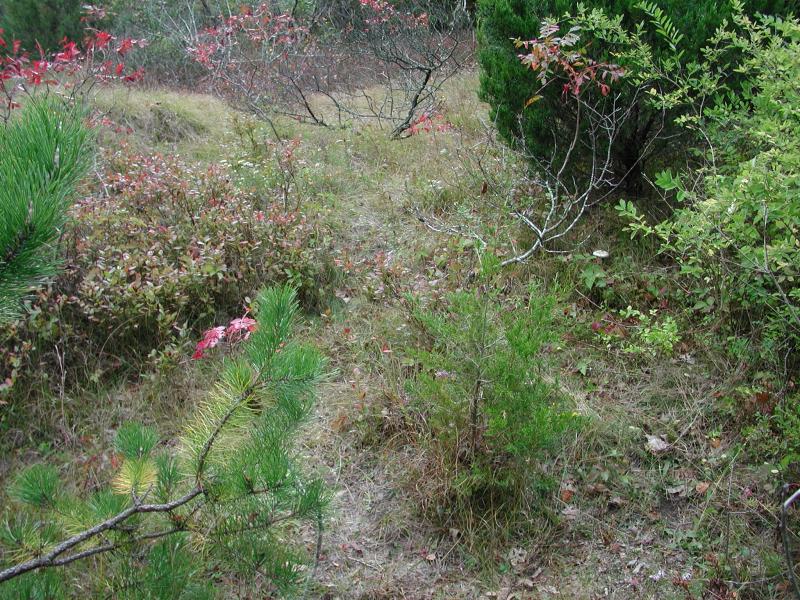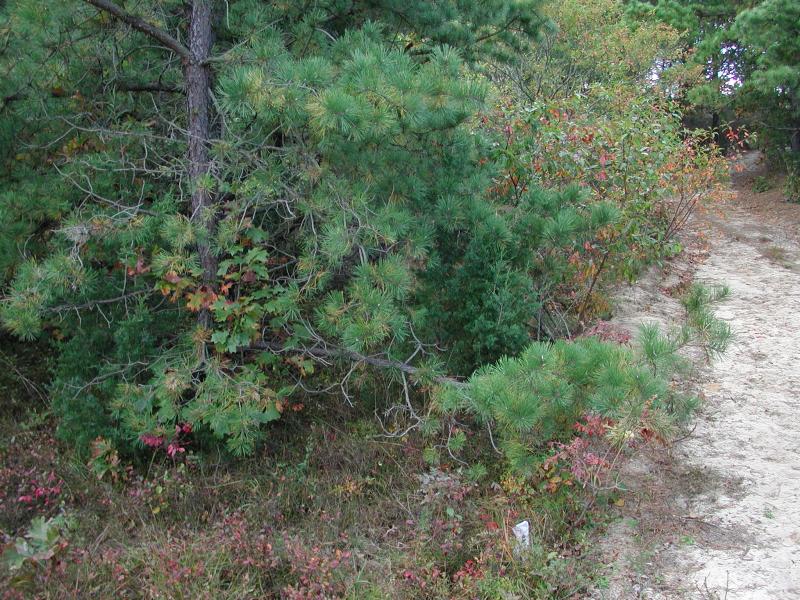Eastern Silvery Aster
Symphyotrichum concolor var. concolor None
- Class
- Dicotyledoneae (Dicots)
- Family
- Asteraceae (Aster Family)
- State Protection
- Endangered
Listed as Endangered by New York State: in imminent danger of extirpation in New York. For animals, taking, importation, transportation, or possession is prohibited, except under license or permit. For plants, removal or damage without the consent of the landowner is prohibited.
- Federal Protection
- Not Listed
- State Conservation Status Rank
- SH
Historical (Possibly extirpated) in New York - Missing from New York; known only from historical records (more than 30 years ago), but still some possibility of rediscovery upon further searching.
- Global Conservation Status Rank
- G5T5
Secure globally - Both the species as a whole and the subspecies/variety are common in the world; widespread and abundant (but may be rare in some parts of its range).
Summary
Did you know?
We are unsure of why this once common aster is so rare now. Plenty of suitable habitat apparantly remains, although many of its former sites on western Long Island and New York City have been developed.
State Ranking Justification
There is only one known population on the verge of being extirpated. There are approximately 30 historical occurrences, but despite extensive searches only one occurrence has been seen. No other records of this conspicuous aster have been reported recently. There are probably only a few other occurrences in New York.
Short-term Trends
The short-term trend is strongly negative. The only existing population has severly declined over the last 25 years and may be extirpated.
Long-term Trends
The long-term trend is strongly negative. There are about 30 historical occurrences, some probably quite large and in the larger grasslands, but despite extensive searches only one occurrence has been seen in the last 25 years. This is one of the most dramatic declines of any rare plant in New York State.
Conservation and Management
Threats
Lack of disturbance to maintain the open grassland habitat has led to succession that has reduced plant numbers.
Conservation Strategies and Management Practices
This species needs disturbance to reduce competition from woody plants and more aggressive herbaceous plants. However, too much direct disturbance to the plants will reduce or eliminate the population. Its habitat could be disturbed in the non-growing season to open it up for seed germination and colonization, but direct disturbance should be prevented during the growing season.
Research Needs
Research is needed to determine the causes of such a dramatic decline in populations even though many remnant grasslands still exist. Research is needed to determine the best management option to augment the existing population.
Habitat
Habitat
The only known extant population in New York is along a trail through a sandy grassland succeeding to pine woods; historical records are all from similiarly dry, sandy, and/or pine-dominated habitats (New York Natural Heritage Program 2010). Dry sandy places, often among pines (Gleason & Cronquist 1991). Dry sandy open woods and barrens (Fernald 1970).
Associated Ecological Communities
- Hempstead Plains grassland*
(guide)
A tall grassland community that occurs on rolling outwash plains in west-central Long Island. This community occurs inland, beyond the influence of offshore winds and salt spray.
- Maritime pitch pine dune woodland*
(guide)
A maritime woodland that occurs on stabilized parabolic dunes. The substrate is wind and wave deposited sand that is usually excessively well-drained and nutrient poor. The community is subject to high winds, sand-blasting, salt spray, and shifting substrate.
- Pitch pine-heath barrens*
(guide)
A shrub-savanna community that occurs on well-drained, sandy or rocky soils. The most abundant tree is pitch pine and the shrublayer is dominated by heath shrubs.
- Pitch pine-scrub oak barrens*
(guide)
A shrub-savanna community that occurs on well-drained, sandy soils that have developed on sand dunes, glacial till, and outwash plains.
- Successional maritime forest*
(guide)
A successional hardwood forest that occurs in low areas near the seacoast. This forest is a variable type that develops after vegetation has burned or land cleared (such as pastureland or farm fields). The trees may be somewhat stunted and flat-topped because the canopies are pruned by salt spray. The forest may be dominated by a single species, or there may be two or three codominants.
* probable association but not confirmed.
Associated Species
- Ionactis linariifolius
- Silene caroliniana
- Symphyotrichum patens var. patens (common late purple-aster)
- Vaccinium angustifolium (common lowbush blueberry)
Range
New York State Distribution
This aster was historically common from the New York City area to eastern Long Island, but now barely survives at one location on eastern Long Island.
Global Distribution
This aster is found on the Coastal Plain and Piedmont Plateau in the Southeast US from Louisiana north to Kentucky and Virginia. It extends up the Atlantic Coast where it is rare from Maryland to Long Island and eastern Massachusetts.
Identification Comments
General Description
Silvery aster is a slender, upright perennial herb, growing in clumps and reaching from 30 to 100 cm tall. The lower and basal leaves are withered by flowering time. The upper leaves are entire, oblong to lanceolate with mucronate tips and 9 to 15 mm long. They are covered with short grayish-green (or silvery) hairs and usually closely appressed to the stem. As with all asters, the infloresences are arranged radially into "heads" of many separate ray and disc flowers, superficially resembling a single flower, and the arrangement of these heads is termed a capitulesence. Silvery Aster may consist of only a single head or may have a narrow panicle, with 1 to 3 heads per branch. The peduncles are densely hairy, with the upper bracts reduced and grading into the phyllaries (involucral bracts). The ray flowers are rose purple and 3 to 10 mm long, and the achenes 2.5 to 3.5 mm long and covered with silky hairs (FNA 2006, Gleason and Cronquist 1991).
Best Life Stage for Proper Identification
The best time to identify Silvery Aster is during flowering.
Similar Species
Symphyotrichum novi-belgii has longer and broader leaves, not covered in silvery hairs, and its petal-like ray flowers are 10-19 mm long (versus 3-10 mm long for S. concolor var. concolor) (FNA 2006).
Best Time to See
Silvery Aster flowers from late September to early October.
- Flowering
- Fruiting
The time of year you would expect to find Eastern Silvery Aster flowering and fruiting in New York.
Eastern Silvery Aster Images
Taxonomy
Eastern Silvery Aster
Symphyotrichum concolor var. concolor None
- Kingdom Plantae
- Phylum Anthophyta
- Class Dicotyledoneae
(Dicots)
- Order Asterales
- Family Asteraceae (Aster Family)
- Order Asterales
- Class Dicotyledoneae
(Dicots)
- Phylum Anthophyta
Synonyms
- Aster concolor L.
- Virgulus concolor (L.) Reveal & Keener
Additional Resources
Best Identification Reference
Flora of North America Editorial Committee. 2006. Flora of North America North of Mexico. Vol. 20. Magnoliophyta: Asteridae, Part 7: Asteraceae, part 2. Oxford Univ. Press, New York. xxii + 666 pp.
Other References
Clemants, Steven and Carol Gracie. 2006. Wildflowers in the Field and Forest. A Field Guide to the Northeastern United States. Oxford University Press, New York, NY. 445 pp.
Fernald, M.L. 1950. Gray's manual of botany. 8th edition. D. Van Nostrand, New York. 1632 pp.
Gleason, Henry A. and A. Cronquist. 1991. Manual of Vascular Plants of Northeastern United States and Adjacent Canada. The New York Botanical Garden, Bronx, New York. 910 pp.
Holmgren, Noel. 1998. The Illustrated Companion to Gleason and Cronquist's Manual. Illustrations of the Vascular Plants of Northeastern United States and Adjacent Canada. The New York Botanical Garden, Bronx, New York.
Mitchell, Richard S. and Gordon C. Tucker. 1997. Revised Checklist of New York State Plants. Contributions to a Flora of New York State. Checklist IV. Bulletin No. 490. New York State Museum. Albany, NY. 400 pp.
New York Natural Heritage Program. 2010. Biotics database. New York Natural Heritage Program. New York State Department of Environmental Conservation. Albany, NY.
New York Natural Heritage Program. 2024. New York Natural Heritage Program Databases. Albany, NY.
Newcomb, Lawrence. 1977. Newcomb's Wildflower Guide: An Ingenious New Key System for Quick, Positive Field Identification of the Wildflowers, Flowering Shrubs, and Vines of Northeastern and North-Central North America. Little, Brown and Company. Boston.
Weldy, T. and D. Werier. 2010. New York flora atlas. [S.M. Landry, K.N. Campbell, and L.D. Mabe (original application development), Florida Center for Community Design and Research http://www.fccdr.usf.edu/. University of South Florida http://www.usf.edu/]. New York Flora Association http://newyork.plantatlas.usf.edu/, Albany, New York
Zaremba, Robert E. 1991. Corrections to phenology list of April 9, 1991.
Links
About This Guide
Information for this guide was last updated on: February 28, 2011
Please cite this page as:
New York Natural Heritage Program. 2024.
Online Conservation Guide for
Symphyotrichum concolor var. concolor.
Available from: https://guides.nynhp.org/eastern-silvery-aster/.
Accessed July 27, 2024.



